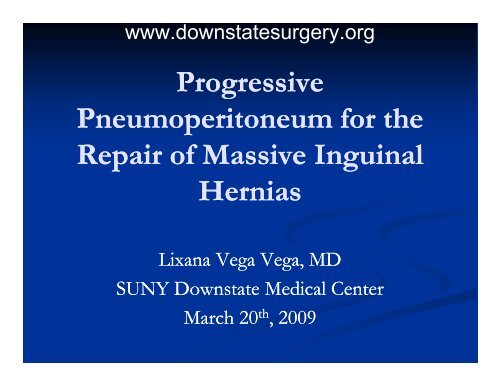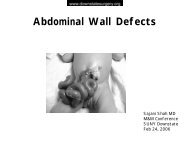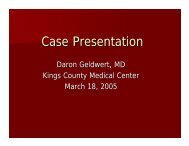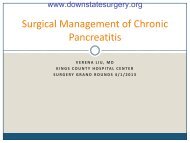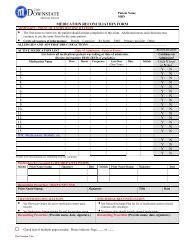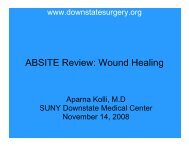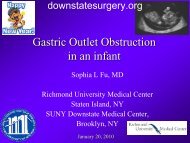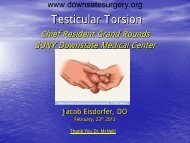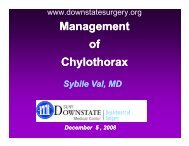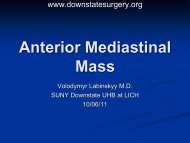Progressive Pneumoperitoneum for the Repair of Massive Inguinal ...
Progressive Pneumoperitoneum for the Repair of Massive Inguinal ...
Progressive Pneumoperitoneum for the Repair of Massive Inguinal ...
- No tags were found...
Create successful ePaper yourself
Turn your PDF publications into a flip-book with our unique Google optimized e-Paper software.
www.downstatesurgery.org<strong>Progressive</strong><strong>Pneumoperitoneum</strong> <strong>for</strong> <strong>the</strong><strong>Repair</strong> <strong>of</strong> <strong>Massive</strong> <strong>Inguinal</strong>HerniasLixana Vega Vg Vega, Vg,MDSUNY Downstate Medical CenterMarch h20 th , 2009
www.downstatesurgery.orgACGME Core Competencies• Patient Care• Medical knowledge• Practice Based dLearning &Improvement• Interpersonal & Communication Skills• Pr<strong>of</strong>essionalism• Systems based practice
Case presentation• 74 y/o male presented to surgery clinic with a massiveright inguinal hernia, that became progressively largerover <strong>the</strong> past 20 years.• Intermittent right groin pain.• Urinary incontinence.i• <strong>Progressive</strong> impairment <strong>of</strong> activities <strong>of</strong> daily living(ambulation).• PMH- Alzheimer's disease recently diagnosed• Meds- AA ASA• PSH- denies• Allergies-NKDAwww.downstatesurgery.org
• Abdomen• Scaphoid, s<strong>of</strong>t, nontender,nondistended.• Right groinwww.downstatesurgery.orgPhysical Exam• <strong>Massive</strong> right inguinal hernia withscrotum extending to knee caps.• Hernia nontender.• Scrotum does not translluminate.• Left groin- no palpable hernias.• Labs – WNL
www.downstatesurgery.orgAbdomen and Pelvis CT Scan
www.downstatesurgery.orgAbdomen and Pelvis CT Scan
www.downstatesurgery.orgAbdomen and Pelvis CT Scan
www.downstatesurgery.orgCase Presentation• 74 y/o male with massive right inguinal hernia withloss <strong>of</strong> intraabdominal domain, affecting ADL.• Standard reduction and primary repair• Abdominal compartment t syndrome.• Respiratory distress.• Hernia recurrence.• <strong>Progressive</strong> Preoperative <strong>Pneumoperitoneum</strong>• Insufflation <strong>of</strong> ambient air into peritoneal cavity inorder to accommodate herniated viscera at time <strong>of</strong>hernia repair.
www.downstatesurgery.org<strong>Progressive</strong> Preoperative<strong>Pneumoperitoneum</strong>• Peritoneal dialysis ca<strong>the</strong>ter placed and oneliter <strong>of</strong> air was insufflated into <strong>the</strong> abdomen.• During each clinic visit (every 2 – 3 days <strong>for</strong> a20 day period) approximately one liter <strong>of</strong>ambient air was introduced to <strong>the</strong> abdominalcavity via <strong>the</strong> dialysis ca<strong>the</strong>ter.• Pt tolerated procedure well. Denied abdominalpain, n/v or dyspnea.• Pt admitted <strong>for</strong> bowel prep prior to RIH repair.
www.downstatesurgery.orgRight inguinal hernia repair• Long right inguinal incision.• <strong>Massive</strong> inguinal herniaextending to right scrotum.• Right colon and loops <strong>of</strong> smallbowel within sac• Contents <strong>of</strong> spermatic cord wereidentified and isolated.• Contents <strong>of</strong> <strong>the</strong> hernia werereduced to <strong>the</strong> abdomen afterincision on <strong>the</strong> anteriorabdominal wall, lateral tointernal ring.• Residual hernia sac was resected.
www.downstatesurgery.orgRight inguinal hernia repair• Vas deferens and testicle wereplaced in <strong>the</strong> scrotum.• The hernia defect extended from<strong>the</strong> pubic tubercle, towards <strong>the</strong>internal ring including <strong>the</strong> entireinguinal floor.• Proced mesh 4 x 5.5cm (withkeyhole <strong>for</strong> spermatic cord) wassecured with 0 Tevdek suture topubic tubercle, inguinal ligamentand superior edge <strong>of</strong> internaloblique muscle aponeurosis.
www.downstatesurgery.orgRight inguinal hernia repair• Aponeurosis <strong>of</strong> external obliquemuscle was closed with 2-0 vicrylrunning sutures.• Peak airway pressures increasedslightly from low 20s to upper20s. No respiratory distress uponfull reduction <strong>of</strong> herniatedviscera.• Peritoneal dialysis ca<strong>the</strong>terremoved via infraumbilicallincision .• Pt was extubated in OR andtransferred to SICU.
• POD #2• Pt started on clears.Post-op op course• Abdomen became mildly distended.• AXR showed large stomach air bubble.• Pt placed NPO. NGT placed.• Bladder pressures WNL• POD#5• Abdominal distention improved. Pt started on clears.• POD #8• Tolerating clears, +flatus, +BM, transferred to floor.• POD #9www.downstatesurgery.org• Advanced to regular diet
• POD#10www.downstatesurgery.org• Mild respiratory distress• Chest CT positive <strong>for</strong> PEPost-op op course• Pt transferred to SICU and started on heparin drip.• AXR showed gastric distention.• POD #14- Abdominal distention persisted• CT scan positive i <strong>for</strong> intraabdominal i lh hematoma and d151.5cmpseudoaneurysm <strong>of</strong> pancreaticoduodenal artery (PDA)• POD#15- angiogram and coil embolization <strong>of</strong> inferior PDA.• POD #16- Pt started on clears, transferred to floor.• POD #17- Advanced to regular diet.• POD #24- discharged to rehab facility.
www.downstatesurgery.org<strong>Progressive</strong><strong>Pneumoperitoneum</strong> <strong>for</strong> <strong>the</strong><strong>Repair</strong> <strong>of</strong> <strong>Massive</strong> <strong>Inguinal</strong>Hernias
www.downstatesurgery.orgMegahernia• Hernia that exceeds20cm in diameter andhas lost its right <strong>of</strong>domicile in <strong>the</strong> peritonealcavity <strong>for</strong> a period <strong>of</strong> oneyear.¹
www.downstatesurgery.orgLoss <strong>of</strong> domain induces• Impaired venous and lymphatic return fromviscera due to compression from <strong>the</strong> herniadefect. ¹• Dilation <strong>of</strong> mesentery and bowel wall edema.• Impairs reduction• Decrease in intraabdominal pressure• Decrease capacity <strong>of</strong> <strong>the</strong> abdominal cavity• Hemidiaphragm lowers altering ventilatorymechanism.
www.downstatesurgery.orgPossible complications <strong>of</strong>reduction• Increased abdominal pressure• Decreased venous return.• Abdominal compartment syndrome.• Elevation <strong>of</strong> diaphragm• Increased thoracic pressure causing respiratorydistress. 2• Dhi Dehiscence with ihh hernia recurrence. 1
www.downstatesurgery.orgAlternatives <strong>of</strong> repair• Resection omentum and bowel.• Increase morbidity/mortality associated with bowelresection.• Short gut syndrome - nutritional problems• Requires a separate incision. 1• Phrenectomy (Tourn<strong>of</strong>f-1950s)• Respiratory complications.3
www.downstatesurgery.orgAlternatives <strong>of</strong> repair• Creation <strong>of</strong> ventral hernia(Ziffrinand Womack-1950)4• Long transverse abdominal incision.• Division <strong>of</strong> abdominal wall except <strong>the</strong> peritoneum.• Reduction and repair <strong>of</strong> inguinal hernia.• Peritoneum protrudes through unsutured fascia (ventralherniation).• Closure <strong>of</strong> fascia (ventral hernia repair) 12 days later.• Useful when size <strong>of</strong> hernia was misjudged pre-op, andwhen pt develops circulatory or repiratory distress intra-op.• Requires a second surgical procedure.
www.downstatesurgery.orgAlternatives <strong>of</strong> repair• Preoperative <strong>Progressive</strong> <strong>Pneumoperitoneum</strong>• Ivan Goni Moreno (1940s)•Intraperitoneal injection <strong>of</strong> oxygen to expand <strong>the</strong>abdominal cavity be<strong>for</strong>e hernia repair, making room toaccommodate herniated viscera.•First case reported was repair <strong>of</strong> incarcerated epigastrichernia.5•Reported 3% recurrance rate in a series <strong>of</strong> 487 gian<strong>the</strong>rnia repairs.
www.downstatesurgery.orgAlternatives <strong>of</strong> repair• Preoperative <strong>Progressive</strong> <strong>Pneumoperitoneum</strong>• Koontz and Graves (1954)•Reported successfull repair abdominal wallhernias with loss <strong>of</strong> domicile with this technique. 4• This technique was <strong>the</strong>n applied to inguinal herniarepairs and <strong>for</strong> repair <strong>of</strong> omphaloceles. 3
• Indicationwww.downstatesurgery.orgPreoperative <strong>Progressive</strong><strong>Pneumoperitoneum</strong>• <strong>Repair</strong> massive abdominal wall hernias with loss <strong>of</strong>intraabdominal domain.6• Contraindications• Advanced d age and poor general condition.• Cardiac decompensation. 1
www.downstatesurgery.orgAdvantages <strong>of</strong> Preoperative<strong>Progressive</strong> <strong>Pneumoperitoneum</strong>• Stretches <strong>the</strong> abdominal wall, creating a larger cavity<strong>for</strong> operative reduction <strong>of</strong> herniated viscera.• Stretches <strong>the</strong> hernia sac causing elongation <strong>of</strong>adhesions, <strong>for</strong> an easier dissection.• Induces preoperative respiratory and circulatoryadjustments to <strong>the</strong> elevation <strong>of</strong> <strong>the</strong> diaphragm. 5• Increases tone <strong>of</strong> fddiaphragm.
www.downstatesurgery.orgTechnique <strong>for</strong> Establishing<strong>Pneumoperitoneum</strong>• Intermittent percutaneous puncture <strong>of</strong> abdominal wall• Spinal needle or a 16-gaugeangiocath.• Increased risk <strong>of</strong> bowel per<strong>for</strong>ation.• Abdominal indwelling ca<strong>the</strong>ter• Started by Steichen in 1965. 3• Modified Seldinger technique.• Ca<strong>the</strong>ter connected to a 3-way stop-cock attached to asyringe.
www.downstatesurgery.org
Technique <strong>for</strong> Establishing<strong>Pneumoperitoneum</strong>• Injection <strong>of</strong> 500 to 1500ml <strong>of</strong> ambient air upon<strong>the</strong> first treatment.• Injection <strong>of</strong> air isstopped ifwww.downstatesurgery.org• Diffuse abdominal pain• lumbar or shoulder pain,• dyspnea or palpitations. 2• Air is withdrawn ifdiscom<strong>for</strong>t persists.
www.downstatesurgery.orgTechnique <strong>for</strong> Establishing<strong>Pneumoperitoneum</strong>• Total amount <strong>of</strong> air injecteddepends on• size <strong>of</strong> hernia and abdominal cavity• presence <strong>of</strong> adhesions• individual patient tolerance. 7• Air injections every 2 - 5days<strong>for</strong>ten days to three weeks prior tosurgery.• Insufflations done as outpatient,bed rest not necessary.• Spirometry pre-op.8
www.downstatesurgery.orgResults <strong>of</strong> <strong>Progressive</strong> Preoperative<strong>Pneumoperitoneum</strong>Hernia repairsPeriod <strong>of</strong>pneumoperitoneumType <strong>of</strong>repairResults and complications1 inguinal 19 days via McVay Successful hernia reductionpuncture w. aand primary repairspinal needleAli et al(1975-Washington DC) 1Coopwood et al 1 inguinal 5-6 days via(1987- 1 incsicional puncture w. 16GTennessee) 8 angioca<strong>the</strong>rLichtensteinNo recurrance at 2 yr f/uNo complicationsiMayagoitia et al 1 inguinal, 9.3 days via Lichtenstein Failed pneumoperitoneum 2(2005-Mexico) 6 11 ventral indwelling cath Wound dinfx 1SQ emphysema 1Abdominal discom<strong>for</strong>tRodriguez Ortega 2 inguinal,1-3 weeks viaLichtensteinNo recurrences in 10mo-et al(2005-Spain) 21 umbilical,1 incisionalJP drain11yrs f/u
Complications <strong>of</strong> Preoperative<strong>Progressive</strong> <strong>Pneumoperitoneum</strong>• Organ per<strong>for</strong>ation.www.downstatesurgery.org• Subcutaneous emphysema.• Epigastric i pain, sensation <strong>of</strong> gastric fullness.• Hematoma <strong>for</strong>mation.• Spontaneous dissection <strong>of</strong> <strong>the</strong> gallbladder from <strong>the</strong>hepatic bed.• Air emboli.• Failure to establish pneumoperitoneum(intraabdominaladhesions from previous surgery) 6
www.downstatesurgery.orgConclusion• <strong>Progressive</strong> preoperative pneumoperitoneum is auseful fl adjunct ti in <strong>the</strong> repair rpir <strong>of</strong> fm massive inguinal i lhriherniaswith loss <strong>of</strong> domain.• It gradually expands <strong>the</strong> abdominal cavity andincreases in intraabdominal and thoracic pressures,that may prevent abdominal compartment syndromeand acute respiratory distress upon hernia reduction.• Complications similar to those <strong>of</strong> pneumoperitoneum<strong>for</strong> laparoscopic surgery.
References1. Ali SD, Calhoun T, Kurtz LH (1975) The Use <strong>of</strong> <strong>Pneumoperitoneum</strong> in <strong>the</strong> Treatment t <strong>of</strong> Megaherniae. JNMA 67:16-18.18.2. Rodriguez M, Garaulet P, Rios R, Jimenez V, Limones E (2006) <strong>Pneumoperitoneum</strong> in <strong>the</strong> Treatment <strong>of</strong>Giant Hernias. Cir Esp 80: 220-223.223.3. Winfield R, Del Guercio L (1989) The Place <strong>for</strong> <strong>Pneumoperitoneum</strong> in <strong>the</strong> <strong>Repair</strong> <strong>of</strong> <strong>Massive</strong> Hernia.World J Surg 13: 581-585. 585.4. Koontz AR, Graves JW (1954) Preoperative <strong>Pneumoperitoneum</strong> as an Aid in <strong>the</strong> Handling <strong>of</strong> GiganticHernias. Annals Surg 140: 759-762. 762.5. Moreno IG (1947) Chronic Eventrations and Large Hernias: Preoperative Treatments by <strong>Progressive</strong><strong>Pneumoperitoneum</strong>: Original Procedure. Surgery 22: 945-953. 953.6. Mayagoitia JC, Suarez D, Arenas JC, Diaz de Leon V (2005) Preoperative <strong>Progressive</strong> <strong>Pneumoperitoneum</strong>in Patients with Abdominal Wall Hernias. World J Hernia Abd Wall SrgOct Surg 20057. Connolly DP, Perri FR Giant Hernias Managed by <strong>Pneumoperitoneum</strong> (1969) JAMA 209: 71-74748. Coopwood RW, Smith RJ (1988) Treatment <strong>of</strong> Large Ventral and Scrotal Hernias Using Preoperative<strong>Pneumoperitoneum</strong>. J NMA 81: 402-404. 404.9. Valliattu AJ, Kingsnorth (2008) Single-stage repair <strong>of</strong> giant inguinoscrotal hernias using <strong>the</strong> abdominal wallcomponent separation technique. Hernia 12: 329-330. 330.10. Beitler JC, Gomes SM, Coelho ACJ, Manso JEF (2009) Complex inguinal hernia repairs.Hernia 2009:13-6161-666611. Ekwww.downstatesurgery.orgEk EW, Ek ET, Bingham R, Wilson J, Mooney B, Banting SW, Burt J (2006) Component Separation in <strong>the</strong><strong>Repair</strong> <strong>of</strong> a Giant Inguinoscrotal Hernia. ANZ J Surg 76: 950-952. 952.
www.downstatesurgery.orgQuestions1. Indications <strong>for</strong> preoperative progressivepneumoperitoneum include:a) Patient with giant inguinal hernia and poor generalmedical condition.b) <strong>Massive</strong> abdominal wall hernias with loss <strong>of</strong>intraabdominal domain.c) Strangulated inguinal hernia with evidence <strong>of</strong>ischemic bowel.d) Small reducible inguinal hernias.
www.downstatesurgery.orgQuestions2. Loss <strong>of</strong> intraabdominal domain induces all <strong>of</strong><strong>the</strong> following except:a) Impaired venous and lymphatic return fromviscera due to compression from <strong>the</strong> hernia defectcausing dilation <strong>of</strong> mesentery and bowel walledema.b) Decrease in intraabdominal pressure.c) Decrease capacity <strong>of</strong> <strong>the</strong> abdominal cavity.d) Elevation <strong>of</strong> <strong>the</strong> diaphragm.
www.downstatesurgery.orgQuestions3. Possible complications <strong>of</strong> reduction <strong>of</strong> massiveinguinal hernias include:a) Increased abdominal pressure and decreasedvenous return leading abdominal compartmentsyndrome.b) Elevation <strong>of</strong> diaphragm leading to increasedthoracic pressure causing respiratory distress.c) Dehiscence with hernia recurrence.d) All <strong>of</strong> <strong>the</strong> above.
www.downstatesurgery.orgQuestions4. Regarding establishment <strong>of</strong> pneumoperitoneumall are correct except:a) Injection <strong>of</strong> air is done via indwelling ca<strong>the</strong>ter.b) Injection <strong>of</strong> air is stopped when patient complaints<strong>of</strong> diffuse abdominal pain, lumbar or shoulderpain, dyspnea or palpitations.ic) Injection <strong>of</strong> air is done on an in-patient basis.d) <strong>Pneumoperitoneum</strong> can be effectivelyinstituted from ten days to three weeks prior tosurgery.
www.downstatesurgery.orgQuestions5. The advantages <strong>of</strong> Preoperative <strong>Progressive</strong><strong>Pneumoperitoneum</strong> include:a) Stretching <strong>of</strong> <strong>the</strong> abdominal wall, creating a larger cavity<strong>for</strong> operative reduction <strong>of</strong> herniated viscera.b) Stretching <strong>of</strong> <strong>the</strong> hernia sac causing elongation <strong>of</strong>adhesions, <strong>for</strong> an easier dissection or reduction.c) Increased tone <strong>of</strong> diaphragm.d) Preoperative respiratory and circulatory adjustments to<strong>the</strong> elevation <strong>of</strong> <strong>the</strong> diaphragm.d)e) All <strong>of</strong> <strong>the</strong> above.
www.downstatesurgery.orgThank you !


